Iberis umbrella: varieties and cultivation
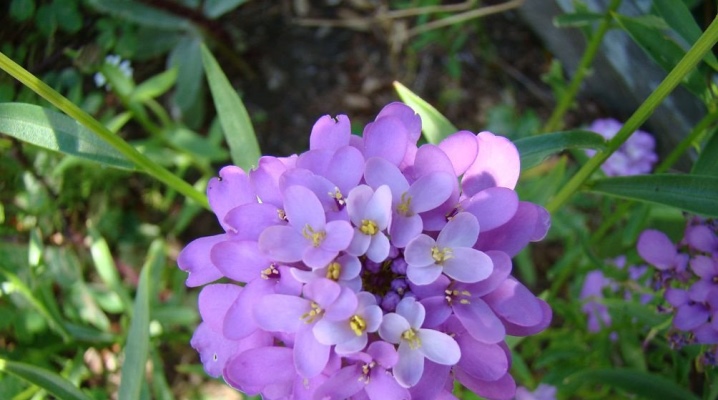
Iberis umbrella strikes with a variety of colors of its varieties - unusual in shape inflorescences can be snow-white, pink, lilac and even dark pomegranate. The culture is extremely unpretentious, but impressive looking, and therefore its cultivation is recommended even for novice gardeners.
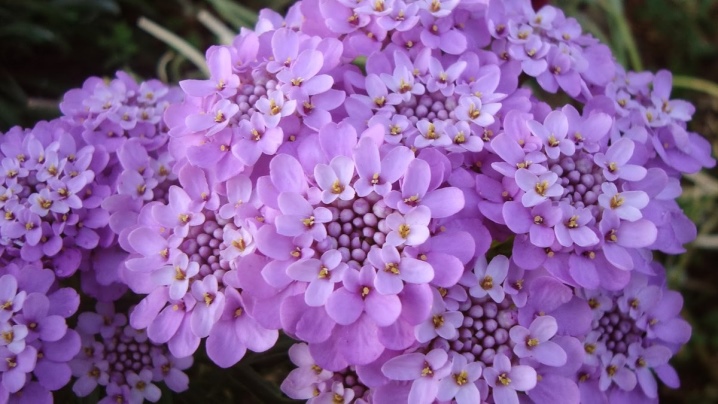
Peculiarities
Iberis umbrella is an annual, a representative of the cruciferous or cabbage family, but unlike most of its relatives, it is not eaten. On the contrary, appearing flowers are used exclusively for decorative purposes to decorate flower beds, lawns and other landscape compositions... In some sources, the name of the culture sounds like Iberian, stennik or peppers. Iberis umbrella is the most popular variety of Iberis. By its appearance, it really resembles an ordinary umbrella.
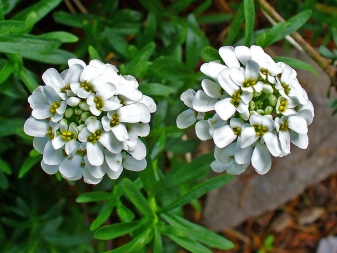
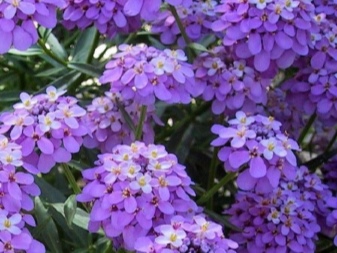
The inflorescences formed from centimeter flowers are quite flat and wide, looking like a single giant bud. Iberis can vary in color from pure white to deep pink or even purple, and bloom lasts for one to two months. The height of the bush reaches only 40 centimeters. The plant looks very neat and attractive due to its small size and rather large inflorescences. Its stem is naked and covered only with down and a small number of rounded leaf plates.
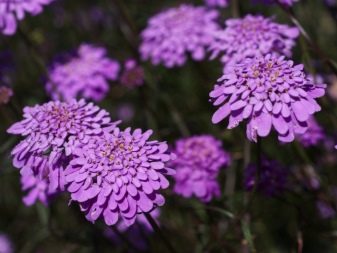
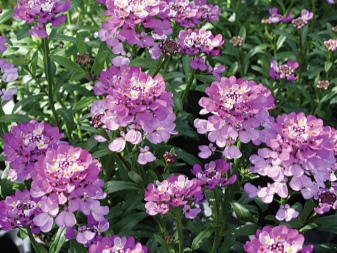
In nature, the umbrella Iberis lives in the countries of Central Europe. In other parts of the world, it is grown, as a rule, in the open field, since the size of the culture turns out to be too large for a pot or container. However, it is not forbidden to pick up a larger container and decorate a balcony or terrace with Iberis.
The best species and varieties
Iberis umbrella has several varieties that are quite popular among gardeners. "Pink Dream" characterized by the presence of spectacular-looking pink-red buds. Abundant flowering is accompanied by the appearance of a pleasant smell.

"Red placer", as you might guess from the name, it pleases flower growers with the purple color of the opened buds.

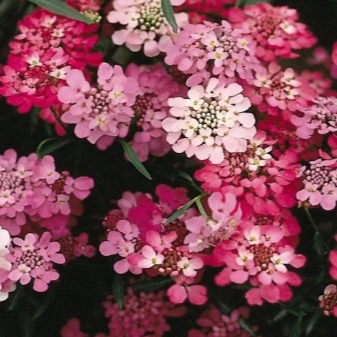
By purchasing a variety Fairy Blend, you can get a mixture of seeds of different colorful shades, which will be a decoration for any garden.
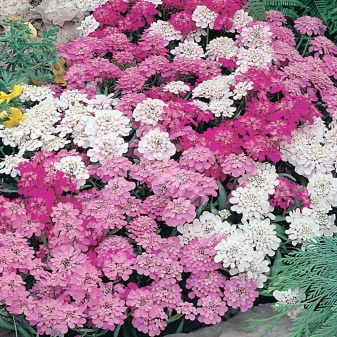
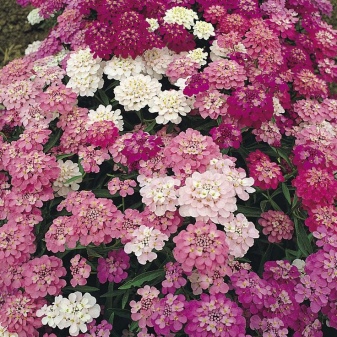
Iberis umbellate hyacinth makes it possible to grow beautiful white inflorescences.
Variety "Iceberg" looks like a sprawling shrub, the height of which reaches 35 centimeters. The plant blooms in late spring, delighting its owners with beautiful snow-white flowers for more than two months. "Iceberg" is a honey plant.
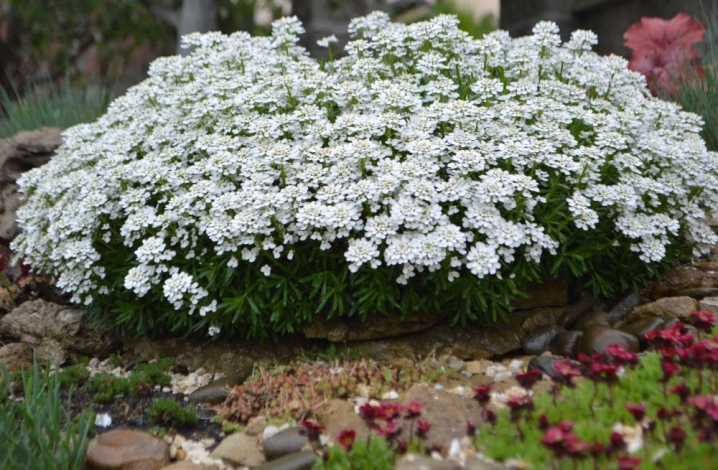
The variety is also popular "Pearl placer" - it is quite unpretentious, but produces beautiful light flowers with a captivating aroma.
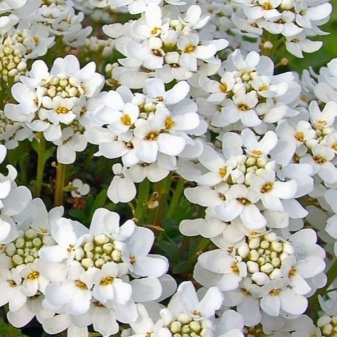
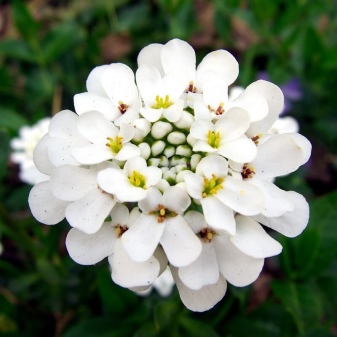
Umbrella irbis buds "Cubic zirconia" reach a diameter of 6 centimeters. Large inflorescences have a light pink tint and bloom in the second half of the first summer month. All in all, "Cubic Zirconia" pleases gardeners with its appearance for about 8-9 weeks.
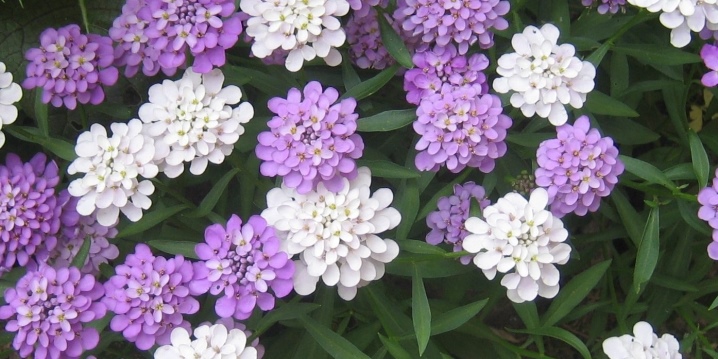
Variety "Blackberry meringue" can be identified by the bushes, reaching a height of 25 to 30 centimeters, covered with multi-colored flowers - from white to rich purple color. The diameter of one inflorescence is only 5 centimeters.
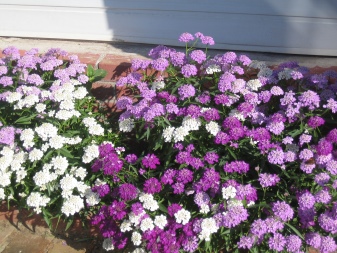
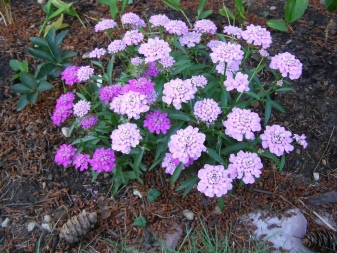
"Pomegranate Ice" looks extremely impressive thanks to the flowers of white and dark pomegranate flowers.This honey plant has a delicious and strong smell.

Variety "Lilitsiana" covered with light purple buds. The shrub, whose height does not exceed 20 centimeters, smells like honey.

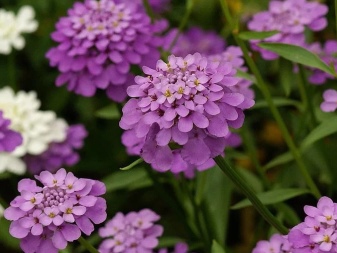
Umbrella Iberis variety "Berry jelly" it has either snow-white or pink color. The diameter of the inflorescence does not exceed 5 centimeters. This variety blooms from July until September.
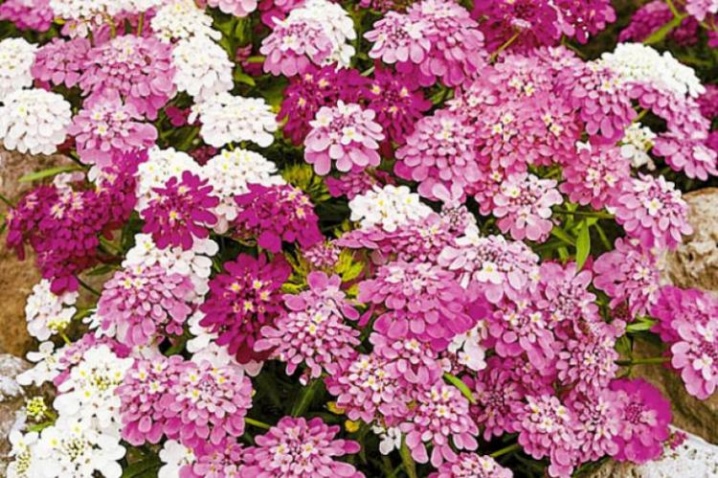
How to plant?
Before planting Umbelliferous Iberis in open ground, it is necessary to check the compliance of the selected site with the basic conditions for growing the crop. The plant reacts poorly to stagnant moisture, so it is better to give preference to either sandy soil or loam. The main criterion for choosing a land should be its water permeability, as well as the ability to pass air to the roots. The site must be well lit, and the flow of sunlight is desirable throughout the day. The absence of it can even lead to the death of Iberis or at least a decrease in the number and size of flowers.
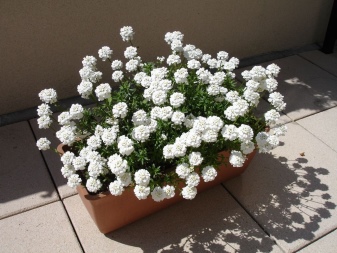
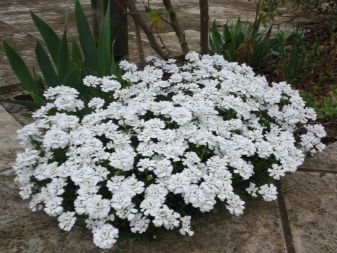
Since the culture is annual, it can be planted in a new place every year. Direct transfer to open ground is carried out in May, when the threat of returning frosts has already lost its relevance.
How to take care of it properly?
Cultivation of umbelliferous Iberis does not seem to be a particularly difficult task, since the culture is considered unpretentious. Irrigation should be regular but moderate. As mentioned above, the plant reacts poorly to stagnant water, and its roots begin to rot, so it will be important to take care of a high-quality drainage layer. Watering is carried out as the soil dries up, that is, in dry weather, its frequency increases, and in rainy weather, on the contrary, decreases. Regular weeding of shrubs is also important, since weeds deprive the soil of nutrients, and therefore disrupt the development of Iberis.
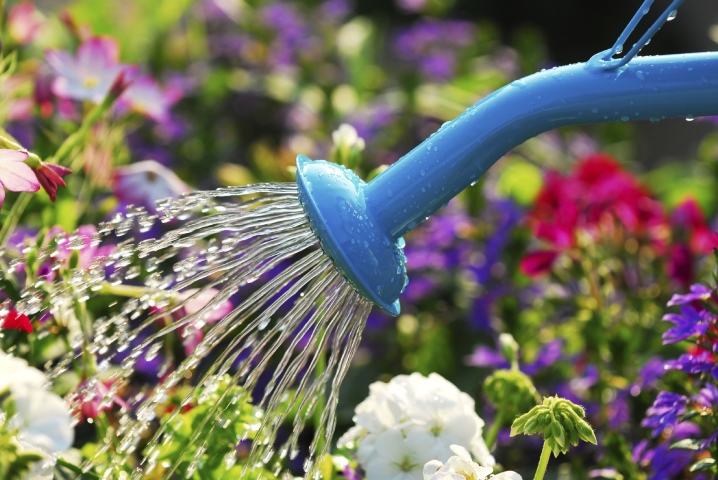
Since the umbrella species is annual, there is no need for pruning. Therefore, in late summer or early autumn, the plant mainly collects seeds and pruned already wilted flowers. This procedure not only contributes to a more aesthetic appearance of the plantings, but also has a beneficial effect on the condition of the plant itself. Iberis needs moderate feeding. Usually fertilizers are applied twice a season - when the first leaves grow, and when the blossoming buds open. The easiest way is to use mineral complexes sold in specialized stores and containing all the substances necessary for the culture.
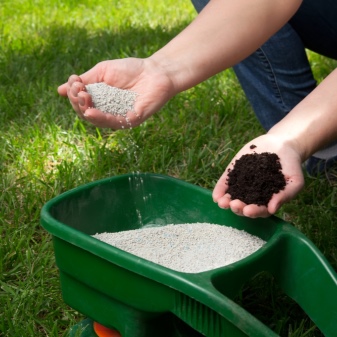

Before the winter season, the annual is completely dug up and burned. After the procedure, the earth is dug up and cleared of roots, debris or stones. During the season, the soil is also regularly loosened to prevent moisture stagnation and transport oxygen to the roots. In addition, in this way the surface crust is destroyed, which interferes with the supply of oxygen.
Reproduction methods
Propagation of umbelliferous Iberis is carried out either with the help of seeds, or by cuttings. In the case of choosing a vegetative method, fragments of branches, the length of which is 5 centimeters, are cut from a bush that has completed flowering. In the future, they are either immediately planted in open ground, or first fall into a greenhouse for rooting. It is possible to speed up the process of root formation with the help of phytohormones. Planting cuttings on open ground should be done in such a way that at least a 15-centimeter gap remains between them.
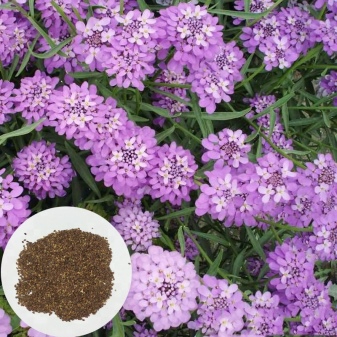
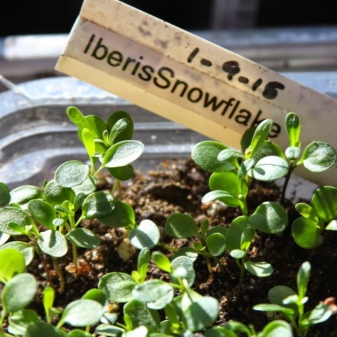
If seeds are selected for reproduction, then the whole process looks a little more complicated. The seed itself can either be collected independently or purchased at a store. The seeds ripen in the pods, which, after being harvested, are first dried and then opened. The resulting seeds are harvested in a dry place, reliably protected from direct sunlight.The next year, the seeds are either planted for seedlings, or immediately sent to the open ground.
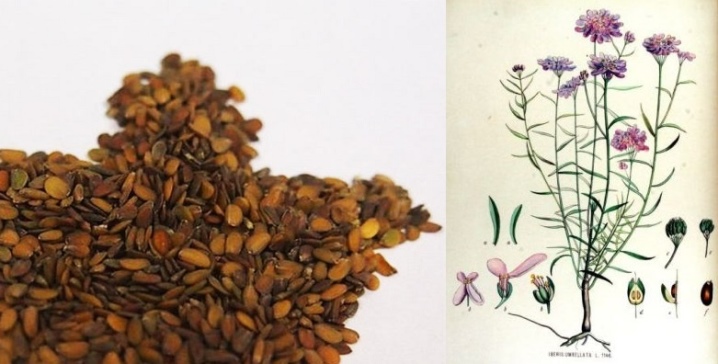
In the second case, sowing is carried out already on the first warm days, but since the earth must still warm up, this does not happen earlier than April. Small grooves are formed in the selected area, and the seeds are deepened by about a centimeter. If we are talking about seedlings, then the seeds are sown in March, and in May they are transplanted to the beds. The material deepens into the moistened soil mixture by only 1 millimeter. It is better to initially make a dive, since the umbrella Iberis does not respond well to transplantation.
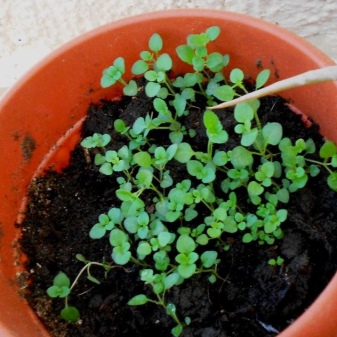
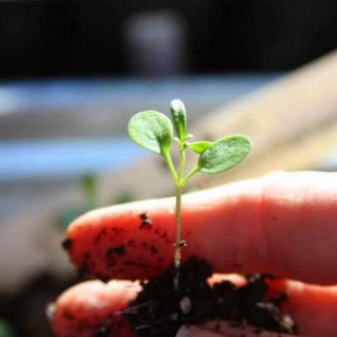
The containers are covered with glass or cling film, or they are removed in a well-heated place. For successful germination, they will need regular ventilation and diffused light. Some gardeners prefer to plant the seedlings further on open ground 2 times - in May and July, in order to ensure a longer flowering period.
Diseases and pests
Most of the diseases of the umbrella Iberis arise from disturbed agricultural practices or the effects of pests. For example, quite often the plant suffers from downy mildew. It is caused by excessive frequency or excessive irrigation of plantings, as well as a prolonged rainy season. The disease is activated by spores of the fungus that live in the remnants of shoots and leaves. Downy mildew can disappear on its own if the weather changes for the better, or watering is reduced. In an emergency, organic methods like garlic solution and specialized preparations are suitable.
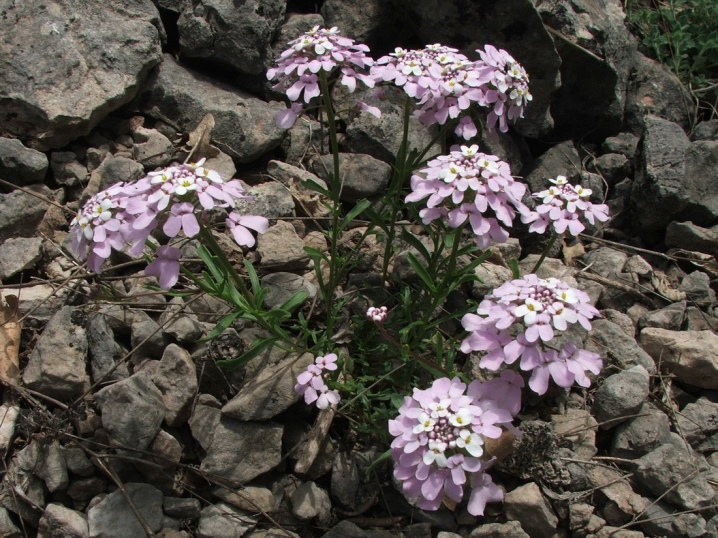
Iberis and keel, which is characteristic of all cruciferous representatives, also often fall ill. Since the infection starts from the roots, gardeners do not immediately notice the problem. The rhizome becomes covered with swellings and growths or, in general, is deformed. Due to the disruption of the activity of the roots, nutrients cease to flow to the aerial part, and the Iberis slows down in development, stops blooming and dries up. Unfortunately, it seems unlikely to preserve the shrub, so it must be destroyed, not forgetting to cultivate the remaining soil.
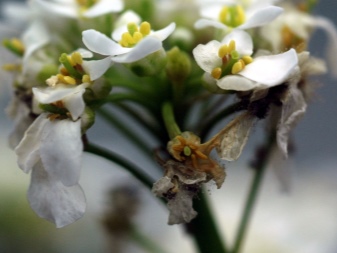
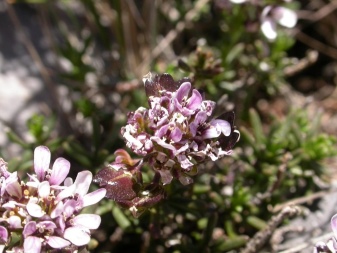
The blackleg kills the Iberis while it is still in seedling. As a preventive measure, treatment with manganese solution and sterilization of the plantings themselves will help here.
Of insects, the culture often suffers from earthen fleas.that feed on foliage and leave behind round holes that can be used to determine their presence. It will be possible to scare off pests with the help of tansy located between the rows. Another common problem is the mealybug, which sucks nutrients out of the Iberis and leaves behind an unpleasant white matter. Copes with insects with ordinary soap dissolved in water, or suitable insecticides.
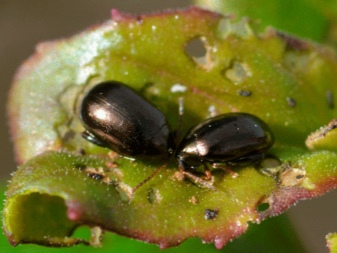
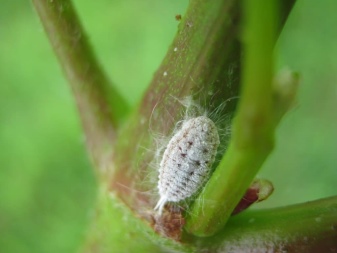
For information on how to properly propagate the umbrella Iberis, see the next video.







































































































The comment was sent successfully.